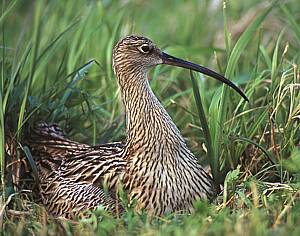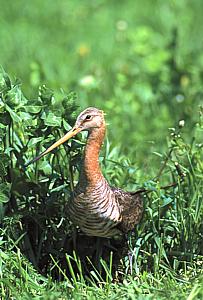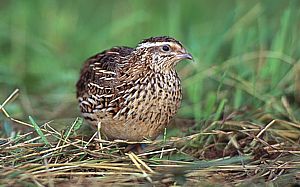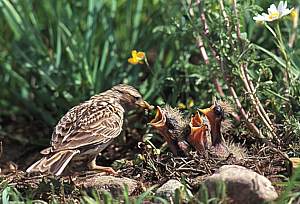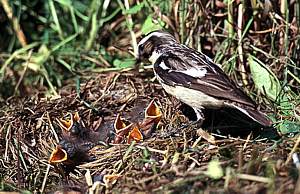|
BIRDS
|
||||||||||||||
Text:
|
Birds of meadows and fields
The areas of Wigry National Park are not forests and waters only but open spaces too which constitute about 17% of its overall area. These are mostly meadows and fields of cultivation, peat bogs and xerothermic grasses. One can observe here a number of birds so characteristic to open spaces such as: pewits, larks, quails or partridges. One can also meet birds from the tattler family. They are characterized by their long legs and beaks thanks to which they can seek food in the coastal areas of water reservoirs. At the time of seeking the food on the meadows their long beaks make their eyes higher than the level of the grasses which consequently enable them to avoid the incoming dangers. The group of birds of meadows and fields includes among others: Eurasian curlew Numenius arquata, black-tailed godwit Limosa limosa, quail Coturnis coturnis, Eurasian skylark Alauda arvensis, and whinchat Saxicola ruberta.
Eurasian curlew Numenius arquata belongs to the snipe-like family. Its body is about 60 cm long, the length of wing varies from 28 to 32 cm. Both male as well as female are colored similarly: grey-brown hair with the long dark blots on a dorsal side of the body. The female is clearly bigger than the male. The beak is long and it is characteristically crooked downwards. It moves slow on the ground and it does not fly very high. It lives among the moist meadows, swamps and steppes. It mainly eats insects, mollusks, little invertebrates, young amphibians as well as berries and seeds. The nests (a shallow depressions in the ground) are built on the ground or on the protruding clusters of sedges. In most cases it seeks the food in the soil and in the mud. The breeding season starts once a year and at that time the female lays 4 eggs which are then incubated by both parents. When the breeding season is over it lives in groups and herds. It flies in March - April and it flies away in July - November. It spends the winter period in the Mediterranean countries, in Africa and in Asia.
Black-tailed godwit Limosa limosa belongs to the snipe-like family. Its body is about 45 cm long, the length of wing is about 20 cm, the weight of body varies from 230 to 370 g. Although the female is similar to the male it is bigger than him. The plumage is grey-brown with dark belts on the back. It lives on the moist meadows, peat bogs and banks of waters. It mainly eats invertebrata and the seeds of plants. The nest is built on the ground in the cluster of grasses or sedges. At the turn of April and of May the female lays 4 eggs which are incubated by both parents. The young are able to fly after 4 weeks. It spends the winter period around the Mediterranean Sea, in Equatorial Africa, in Asia and in Australia.
Quail Coturnis coturnis belongs to the pheasant-like family. These birds are quick and persistent runners but they do not fly very swiftly. They communicate with one another by the means of loud calling. They live in the open spaces such as meadows and fields of cultivation where they can find food consisting of plants and small invertebrates. The length of body is about 19 cm, the spread of wings is 36 cm, the weight reaches 110 g. The female is very similar to the male; the only visible difference is the color of a dewlap - the female has a white dewlap and the male has dark-brown dewlap. The plumage is brown-yellow-grey with darker oblong blots. The nest is built on the ground, hidden among vegetations. At the turn of May and June the female lays 7-16 of eggs which are incubated by her. Quail's nestlings are able to leave the nest right after being hatched. It spends the winter period in the south of Europe, in Africa and in Asia Minor. During the last few years the population of quail has drastically fallen down. The reason for the state of things is the change of character of tillage of farming and the mass hunting during the flight through the Mediterranean countries.
Eurasian skylark Alauda arvensis belongs to the family of larks and is the most characteristic bird of the open spaces. Its body is about 18 cm long, the length of wing is up to 12 cm, the weight of body reaches 40 g. There is a slightly visible crest of feathers on the head. The plumage of male and female is the same: grey and tawny with spots. It lives in the open spaces; in most cases these are meadows and fields of cultivation. It mainly eats insects and seeds of plants. It runs very efficiently on the ground; its claws are long and flat. Thanks to singing the lark distinguishes its district without the necessity of undertaking fights with its neighbor. The nests are built on the dry boundary strips or the areas of short vegetations, not threatened by floods. It has 2-3 breeding seasons starting from April. The female lays 4-5 eggs which are incubated by her. The young leave the nest after 9-11 days. The lark always lands far from the nest and then carefully approaches it wandering among clusters of grasses. Thanks to protective feathers it is almost invisible on the ground. It flies to us in March - April and flies away in September - November. It spends the winter period in the south of Europe, Northern Africa, India and China.
Whinchat Saxicola rubetra belongs to the thrush-like family. Its body is about 12,5 cm long, the length of wing is about ok. 8 cm, the weight of body reaches about 15 g. When the breeding season is over the male and female are colored tawny on the back and cream-like on the abdomen; in spring time the male is colored more contrastively with a rust-colored deposit on the chest and with a yellow drawing on the back. It mostly lives in the moist meadows and peat bogs. It does not fly far, the flight is wavy; sometimes it hangs in the air. It often sits down and makes impetuous wing and tail movements. It eats insects, spiders and worms. It has one or two breeding seasons during the year. The nest (made of leaves of grasses and of young plants with addition of bristles) is built in a pit in the ground under the clusters of grasses. In the second half of May the female lays 5-6 of eggs which are incubated by her. She leaves the nest only in the evening in order to find some food. Both parents look after their nestlings. Saxicola ruberta flies at the end of April and flies away in September. It spends the winter period in Africa, south of the Sahara desert.
|
|||||||||||||
|
|
|
